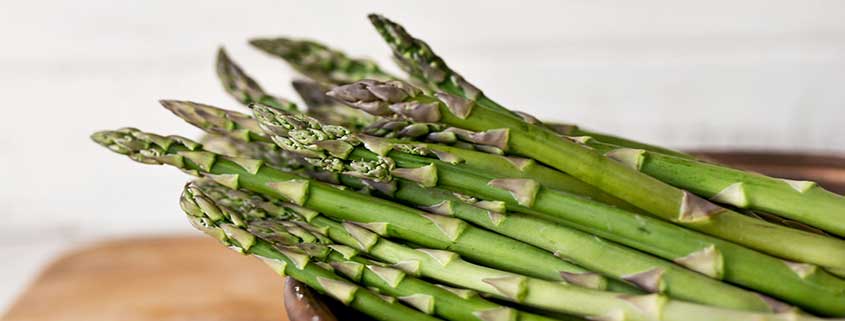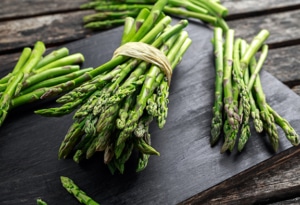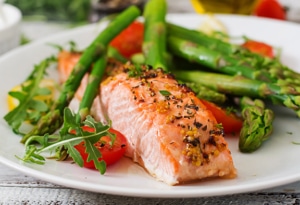
It’s a good idea for people with diabetes to eat lots of vegetables, and one of the best veggies for diabetes is asparagus! Learn why asparagus is a diabetes superfood and how you can add it to your diabetes diet.
Did your parents constantly tell you to “eat your veggies” when you were younger? You might not have enjoyed hearing this as a child, especially if you were a picky eater – but there’s a good reason why it’s such a classic piece of advice. Increased vegetable intake can improve just about anyone’s health, and that’s especially true for people living with diabetes. Veggies are a nutritious source of carbohydrates, and they often come packed with valuable fiber, nutrients, and vitamins.
There’s no denying that asparagus is one of the healthiest vegetables out there, whether you have diabetes or not. And if you are living with diabetes or are trying to reduce your diabetes risk, there’s reason to believe this delicious vegetable can help! Read on to find out what makes asparagus so amazing.

Asparagus May Help Fight Diabetes
According to a study published in the British Journal of Nutrition, adding asparagus to your diet might help you keep diabetes symptoms under control. This study, performed at Pakistan’s Karachi University, looked at rats with diabetes. Half of the rat population received asparagus extract for a month, while the other half received glibenclamide, a drug used to treat type 2 diabetes. The result: Small amounts of the asparagus extract appeared to help with blood sugar control. More significant amounts had the same effect – and the benefit of increased insulin production.
Better yet, this study supports previous research done on the topic of asparagus and diabetes. Another study, which appeared in the British Medical Journal in 2006, found that asparagus consumption was linked to an 81-percent increase in the body’s ability to use glucose.
Even More Asparagus Health Benefits
On its own, the link between asparagus and improved diabetes control would be enough of a reason to put this vegetable on your plate. But the health perks of asparagus don’t stop there! When you make a point of eating asparagus regularly, you’ll also get:
- High levels of folate. One 5.3-ounce serving of asparagus delivers 60 percent of your recommended daily allowance of folacin. The vitamin folate is important for making red blood cells and for cell division.
- Low in calories and with countless nutrients. Asparagus boasts fiber, thiamin, vitamins A, B6, and K – just to name a few.
- Good source of antioxidants. Asparagus is rich in Vitamins C and E, and the antioxidants called flavonoids and polyphenols.
- Antioxidants have been shown to prevent the accumulation of free radicals and may reduce chronic disease.
- Can improve digestive health. Asparagus is high in insoluble fiber which adds bulk to stool and supports regular bowel movements. It also contains small amounts of soluble fiber, which dissolves in water and forms a gel like substance in the digestive tract.
- Lots of minerals. While asparagus is known for its iron and copper content, you’ll also get a bit of potassium, calcium, phosphorus, and manganese from this vegetable. Since it can help lower blood pressure, potassium is vital for treating diabetes.
Asparagus Nutritional Values
Are you looking for the nutritional values for asparagus? Here they are:
| Serving size | 1 cup |
| Calories | 27 |
| Protein | 3 grams |
| Carbohydrates | 5 grams |
| Fat | 0 grams |
| Cholesterol | 0 milligrams |
| Sodium | 3 milligrams |
| Potassium | 271 milligrams |
| Dietary Fiber | 3 grams |
| Protein | 6 percent DV |
| Vitamin A | 20 percent DV |
| Vitamin C | 12 percent DV |
| Iron | 16 percent DV |
| Vitamin B6 | 5 percent DV |
Adding Asparagus to Your Diabetes Diet is Easy
If you’re like many people, eating more vegetables is easier said than done – especially if you have bad memories of eating asparagus as a kid. Still, if you take the time to prepare it right, asparagus can be as delicious as it is nutritious.

Give one of these ideas a try:
- Add asparagus spears to soups, omelets, casseroles, and pasta.
- Serve steamed asparagus with some parmesan and olive oil drizzled on top.
- For extra protein and a unique flavor, eat asparagus along with pistachios or other nuts.
- Make a healthy, delicious appetizer by grilling asparagus stalks with onions and macadamia nut oil.
- Try stir-frying asparagus, along with sesame seeds, pepper, ginger, and garlic for added flavor.
Control Diabetes with Asparagus – And ADS
Whether asparagus is already one of your favorite vegetables or you haven’t eaten it in years, it’s always a bright idea to use this veggie the next time you cook dinner. When you do, you’ll be able to appreciate how it’s helping you manage your diabetes!
Along with eating a healthy diet, a crucial part of diabetes management is ensuring you have the diabetes supplies you need. Whether you use insulin, glucose meters, continuous glucose monitors, or other supplies, you can count on ADS to ship them to you as quickly and reliably as possible!
